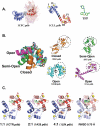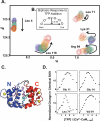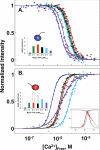Allosteric effects of the antipsychotic drug trifluoperazine on the energetics of calcium binding by calmodulin
- PMID: 20544963
- PMCID: PMC2913171
- DOI: 10.1002/prot.22739
Allosteric effects of the antipsychotic drug trifluoperazine on the energetics of calcium binding by calmodulin
Abstract
Trifluoperazine (TFP; Stelazine) is an antagonist of calmodulin (CaM), an essential regulator of calcium-dependent signal transduction. Reports differ regarding whether, or where, TFP binds to apo CaM. Three crystallographic structures (1CTR, 1A29, and 1LIN) show TFP bound to (Ca(2+))(4)-CaM in ratios of 1, 2, or 4 TFP per CaM. In all of these, CaM domains adopt the "open" conformation seen in CaM-kinase complexes having increased calcium affinity. Most reports suggest TFP also increases calcium affinity of CaM. To compare TFP binding to apo CaM and (Ca(2+))(4)-CaM and explore differential effects on the N- and C-domains of CaM, stoichiometric TFP titrations of CaM were monitored by (15)N-HSQC NMR. Two TFP bound to apo CaM, whereas four bound to (Ca(2+))(4)-CaM. In both cases, the preferred site was in the C-domain. During the titrations, biphasic responses for some resonances suggested intersite interactions. TFP-binding sites in apo CaM appeared distinct from those in (Ca(2+))(4)-CaM. In equilibrium calcium titrations at defined ratios of TFP:CaM, TFP reduced calcium affinity at most levels tested; this is similar to the effect of many IQ-motifs on CaM. However, at the highest level tested, TFP raised the calcium affinity of the N-domain of CaM. A model of conformational switching is proposed to explain how TFP can exert opposing allosteric effects on calcium affinity by binding to different sites in the "closed," "semi-open," and "open" domains of CaM. In physiological processes, apo CaM, as well as (Ca(2+))(4)-CaM, needs to be considered a potential target of drug action.
(c) 2010 Wiley-Liss, Inc.
Figures








Similar articles
-
Markov state modelling reveals heterogeneous drug-inhibition mechanism of Calmodulin.PLoS Comput Biol. 2022 Oct 7;18(10):e1010583. doi: 10.1371/journal.pcbi.1010583. eCollection 2022 Oct. PLoS Comput Biol. 2022. PMID: 36206305 Free PMC article.
-
Opposing orientations of the anti-psychotic drug trifluoperazine selected by alternate conformations of M144 in calmodulin.Proteins. 2015 May;83(5):989-96. doi: 10.1002/prot.24781. Epub 2015 Mar 25. Proteins. 2015. PMID: 25694384 Free PMC article.
-
Inhibitor and peptide binding to calmodulin characterized by high pressure Fourier transform infrared spectroscopy and Förster resonance energy transfer.Biochim Biophys Acta Proteins Proteom. 2018 May-Jun;1866(5-6):617-623. doi: 10.1016/j.bbapap.2018.03.007. Epub 2018 Mar 17. Biochim Biophys Acta Proteins Proteom. 2018. PMID: 29555454
-
Calmodulin binding proteins provide domains of local Ca2+ signaling in cardiac myocytes.J Mol Cell Cardiol. 2012 Feb;52(2):312-6. doi: 10.1016/j.yjmcc.2011.06.005. Epub 2011 Jun 12. J Mol Cell Cardiol. 2012. PMID: 21708171 Free PMC article. Review.
-
Interplay between conformational selection and induced fit in multidomain protein-ligand binding probed by paramagnetic relaxation enhancement.Biophys Chem. 2014 Feb;186:3-12. doi: 10.1016/j.bpc.2013.08.006. Epub 2013 Aug 31. Biophys Chem. 2014. PMID: 24070540 Free PMC article. Review.
Cited by
-
Two-Dimensional NMR Lineshape Analysis.Sci Rep. 2016 Apr 25;6:24826. doi: 10.1038/srep24826. Sci Rep. 2016. PMID: 27109776 Free PMC article.
-
Markov state modelling reveals heterogeneous drug-inhibition mechanism of Calmodulin.PLoS Comput Biol. 2022 Oct 7;18(10):e1010583. doi: 10.1371/journal.pcbi.1010583. eCollection 2022 Oct. PLoS Comput Biol. 2022. PMID: 36206305 Free PMC article.
-
Opposing orientations of the anti-psychotic drug trifluoperazine selected by alternate conformations of M144 in calmodulin.Proteins. 2015 May;83(5):989-96. doi: 10.1002/prot.24781. Epub 2015 Mar 25. Proteins. 2015. PMID: 25694384 Free PMC article.
-
Bilobal architecture is a requirement for calmodulin signaling to CaV1.3 channels.Proc Natl Acad Sci U S A. 2018 Mar 27;115(13):E3026-E3035. doi: 10.1073/pnas.1716381115. Epub 2018 Mar 12. Proc Natl Acad Sci U S A. 2018. PMID: 29531055 Free PMC article.
-
Ca2+-dependent rapid uncoupling of astrocytes upon brief metabolic stress.Front Cell Neurosci. 2023 Oct 11;17:1151608. doi: 10.3389/fncel.2023.1151608. eCollection 2023. Front Cell Neurosci. 2023. PMID: 37886111 Free PMC article.
References
-
- Hidaka H, Ishikawa T. Molecular pharmacology of calmodulin pathways in the cell functions. Cell Calcium. 1992;13:465–472. - PubMed
-
- Newman RA, Van Scyoc WS, Sorensen BR, Jaren OR, Shea MA. Interdomain coopertivity of calmodulin to melittin preferentially increases calcium affinity of sites I and II. Proteins: Structure, Function, and Bioinformatics. 2008;71(4):1792–1812. - PubMed
-
- Sorensen BR, Faga LA, Hultman R, Shea MA. Interdomain linker increases thermostability and decreases calcium affinity of calmodulin N-domain. Biochemistry. 2002;41(1):15–20. - PubMed
-
- Sorensen BR, Shea MA. Interactions between domains of apo calmodulin alter calcium binding and stability. Biochemistry. 1998;37:4244–4253. - PubMed
-
- Zhang M, Tanaka T, Ikura M. Calcium-induced conformational transition revealed by the solution structure of apo calmodulin. Nature Struct Biol. 1995;2:758–767. - PubMed
Publication types
MeSH terms
Substances
Grants and funding
LinkOut - more resources
Full Text Sources
Miscellaneous

